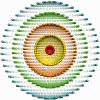Adepth: New Representation and its implications for atomic depths of macromolecules
- PMID: 23609539
- PMCID: PMC3692060
- DOI: 10.1093/nar/gkt299
Adepth: New Representation and its implications for atomic depths of macromolecules
Abstract
We applied the signed distance function (SDF) for representing the depths of atoms in a macromolecule. The calculations of SDF values were performed on grid points in a rectangular box that accommodates the macromolecule. The depth for an atom inside the molecule was then obtained as a result of tri-linear interpolation of SDF values at the nearest grid points surrounding the atom. For testing the performance of present program Adepth, we have constructed an artificial molecule whose atomic depths are known as the gold standard for accuracy assessments. On average, our results showed that Adepth reached an accuracy of 1.6% at 0.5 Å of grid spacing, whereas the current reference server DEPTH reached 7.5%. The Adepth program provides both depth and height representations; it is capable of computing iso-surfaces for atomic depths and presenting graphical view of macromolecular shape at some distance away from the surface. Web interface is available at http://biodev.cea.fr/adepth.
Figures



Similar articles
-
NOMAD-Ref: visualization, deformation and refinement of macromolecular structures based on all-atom normal mode analysis.Nucleic Acids Res. 2006 Jul 1;34(Web Server issue):W52-6. doi: 10.1093/nar/gkl082. Nucleic Acids Res. 2006. PMID: 16845062 Free PMC article.
-
Modeling macro-molecular interfaces with Intervor.Bioinformatics. 2010 Apr 1;26(7):964-5. doi: 10.1093/bioinformatics/btq052. Epub 2010 Feb 7. Bioinformatics. 2010. PMID: 20139468
-
Generating triangulated macromolecular surfaces by Euclidean Distance Transform.PLoS One. 2009 Dec 2;4(12):e8140. doi: 10.1371/journal.pone.0008140. PLoS One. 2009. PMID: 19956577 Free PMC article.
-
UMMS: constrained harmonic and anharmonic analyses of macromolecules based on elastic network models.Nucleic Acids Res. 2006 Jul 1;34(Web Server issue):W57-62. doi: 10.1093/nar/gkl039. Nucleic Acids Res. 2006. PMID: 16845072 Free PMC article.
-
Omokage search: shape similarity search service for biomolecular structures in both the PDB and EMDB.Bioinformatics. 2016 Feb 15;32(4):619-20. doi: 10.1093/bioinformatics/btv614. Epub 2015 Oct 27. Bioinformatics. 2016. PMID: 26508754 Free PMC article.
Cited by
-
Structural and Functional Characterization of the Type Three Secretion System (T3SS) Needle of Pseudomonas aeruginosa.Front Microbiol. 2019 Mar 29;10:573. doi: 10.3389/fmicb.2019.00573. eCollection 2019. Front Microbiol. 2019. PMID: 31001211 Free PMC article.
-
Characterization and structural analysis of a thermophilic GH11 xylanase from compost metatranscriptome.Appl Microbiol Biotechnol. 2021 Oct;105(20):7757-7767. doi: 10.1007/s00253-021-11587-2. Epub 2021 Sep 23. Appl Microbiol Biotechnol. 2021. PMID: 34553251
-
Safety, Stability and Pharmacokinetic Properties of (super)Factor Va, a Novel Engineered Coagulation Factor V for Treatment of Severe Bleeding.Pharm Res. 2016 Jun;33(6):1517-26. doi: 10.1007/s11095-016-1895-3. Epub 2016 Mar 9. Pharm Res. 2016. PMID: 26960296 Free PMC article.
-
Measuring the shapes of macromolecules - and why it matters.Comput Struct Biotechnol J. 2013 Dec 9;8:e201309001. doi: 10.5936/csbj.201309001. eCollection 2013. Comput Struct Biotechnol J. 2013. PMID: 24688748 Free PMC article. Review.
References
-
- Pedersen TG, Sigurskjold BW, Andersen KV, Kjaer M, Poulsen FM, Dobson CM, Redfield C. A nuclear magnetic resonance study of the hydrogen-exchange behaviour of lysozyme in crystals and solution. J. Mol. Biol. 1991;218:413–426. - PubMed
-
- Zhou H, Zhou Y. Quantifying the effect of burial of amino acid residues on protein stability. Proteins. 2004;54:315–322. - PubMed
-
- Liu S, Zhang C, Liang S, Zhou Y. Fold recognition by concurrent use of solvent accessibility and residue depth. Proteins. 2007;68:636–645. - PubMed
-
- Kalidas Y, Chandra N. PocketDepth: a new depth based algorithm for identification of ligand binding sites in proteins. J. Struct. Biol. 2008;161:31–42. - PubMed
Publication types
MeSH terms
Substances
LinkOut - more resources
Full Text Sources
Other Literature Sources

